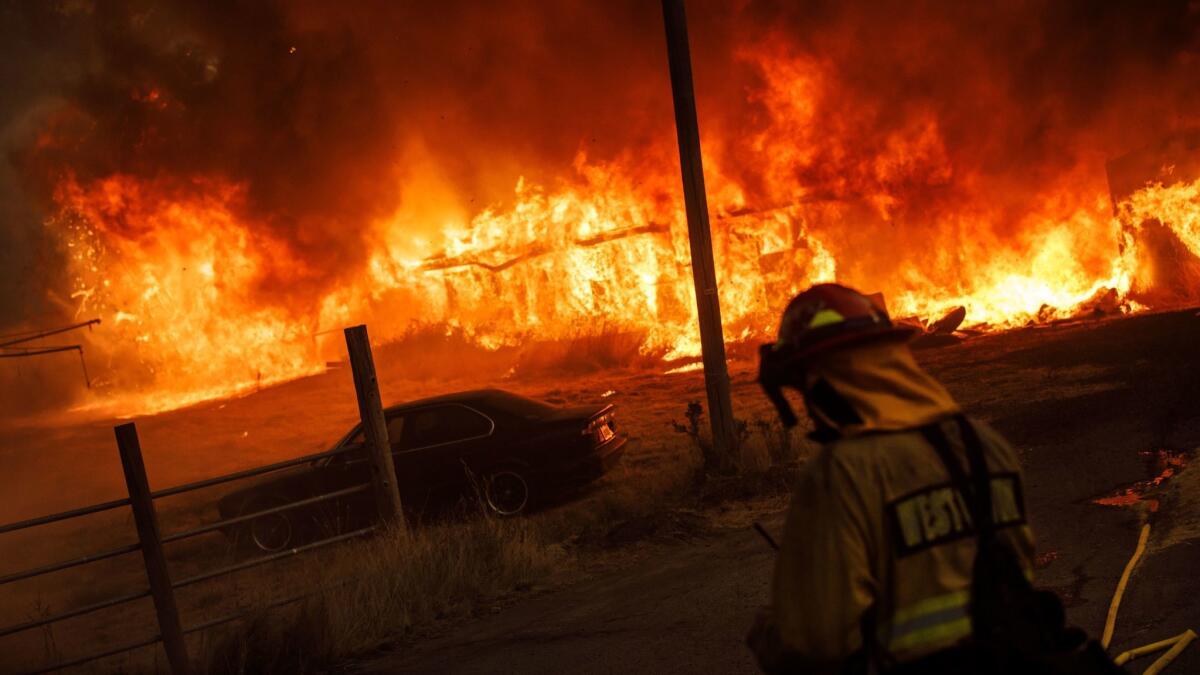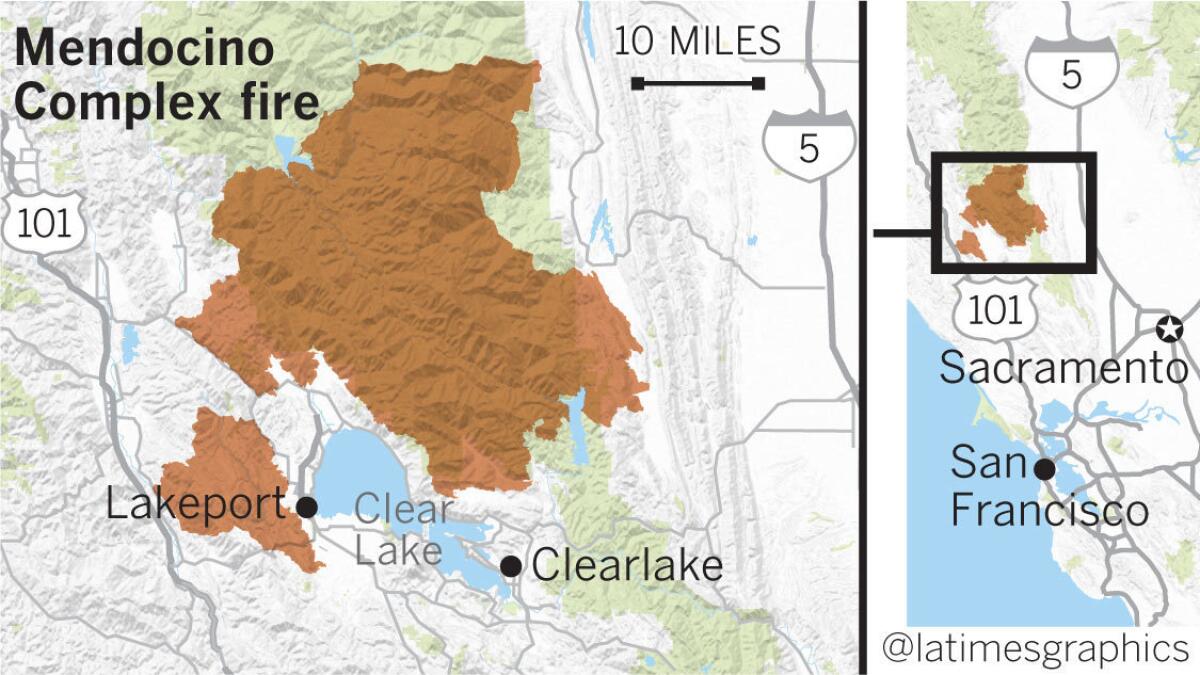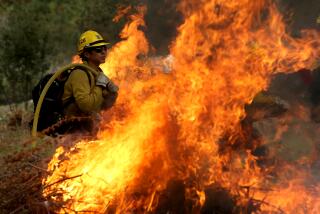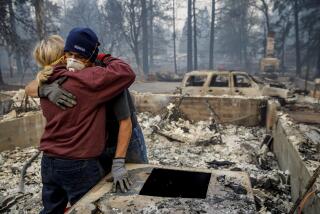Report criticizes fire agencies’ cooperation during Mendocino Complex blaze

Infighting among fire leaders from multiple agencies during the largest wildfire in modern California history created a tense environment that trickled down to ground troops and might have endangered the lives of firefighters, according to a report released Friday.
The report, compiled by staff from the U.S. Forest Service, Cal Fire and the Los Angeles Fire Department, focuses on an Aug. 19 incident in which a group of firefighters from L.A. and the California Department of Forestry and Fire Protection almost died when they became surrounded by flames from the Mendocino Complex fire.
The firefighters were working north of the Snow Mountain Wilderness, attempting to build a fire line to try to keep the Mendocino Complex fire from charging through that portion of the forest and into a creek bed before reaching homes.
At the time, several firefighters on the ground expressed concern that there was no clear plan for how they would build the fire line. The fire’s front was drawing nearer, and the majority of the firefighters assigned to the job were unsure what they were supposed to do.
According to the report, L.A. city firefighters had heard that a crew that had turned down an assignment had been punished and assigned to pick up trash and other mundane tasks. As a result, they plowed forward despite their anxieties.
A shift in wind caused the flames to surround the firefighters, forcing them to scramble to safety through the forest.
Daylight suddenly turned into darkness as embers and ash swirled around the crew. Scanning the area for an elusive escape route, the strike team leader thought: “This is how it ends. We are going to be vaporized.”
One firefighter was flown to a burn center, and another was taken to a hospital for a dislocated shoulder. The other four were treated for burns to their heads and necks.
The report stated that its goal was, in part, to understand why this near-fatal incident occurred and what can be learned from it. Fire investigators also wanted to understand how the tension among leaders might have contributed to the events leading up to the incident.

By the time of the firefighters’ brush with death, the Mendocino Complex fire, which had been burning for almost three weeks, had grown to almost 385,000 acres, about 600 square miles, and firefighters were tired. Just in that day, it had already burned 21,000 acres.
In total, the fire, which started July 27, ended up burning 459,123 acres and destroying 280 structures.
Over the last few months, investigators have interviewed numerous firefighters who worked on the Mendocino Complex fire.
Their report suggests that tension among leaders, along with substantial communication issues, including radio “dead spots” where communication wasn’t possible, might have contributed to the chaos that ensued Aug. 19.
The Cal Fire and U.S. Forest Service “rivalry was evident on this fire, and I believe it was a detriment to the operational tempo and production,” one firefighter told investigators.
Additionally, command staff needed more firefighters, including hotshot crews, but couldn’t get them because of other large wildfires burning across the state, including the Carr, Cranston and Ferguson fires, the report notes.
The Los Angeles Fire Department declined to comment, deferring to Cal Fire. Cal Fire also declined to comment, with a spokesman saying the agency, which helped compile the report, did not yet have a final copy of it.
Ann Carlson, Mendocino National Forest supervisor, said communication is critically important during a large wildfire, and as California will continue to have large wildfires, agencies at every level must find ways to effectively work together, including through training together before disaster strikes.
The Mendocino Complex fire had the potential to burn many homes in the communities surrounding Clear Lake, which was a priority for fire leaders, she said. The fire was regularly burning at least 17,000 acres per day, about 27 square miles.
“It could have been much worse than it was,” Carlson said. “Because the resources were focused on those populated areas, we weren’t able to put as may resources on the unpopulated part, which is the forest ground, and so that’s why it was really actively burning there.”
The near-fatal accident that August day was preceded by substantial leadership issues among the fire’s command staffs.
Generally in California, an incident management team gets assigned to a large wildfire to create an overall strategy for snuffing out the blaze and to help organize the hundreds of firefighters and equipment coming in. These teams often include veteran firefighters with several wildfires under their belts.
Because of the Mendocino Complex fire’s size and intensity, it was determined that two incident management teams were needed, the report noted. This atypical approach created tension among fire leadership because it duplicated jobs. People were confused about who was in charge, and having two management teams added layers of unnecessary bureaucracy, the report said.
This tension and confusion among leadership affected the ground troops, the report notes. Firefighters — already hesitant to speak out against their leaders’ plans — were made more nervous about speaking out about plans they believed were dangerous or that didn’t make sense.
This problem was apparent the day the five LAFD firefighters and one Cal Fire firefighter almost died.
Although several firefighters on the operation safely reached their trucks and escaped, the strike team leader along with four L.A. city firefighters and one Cal Fire firefighter became surrounded by fire.
As ash rained down, they ran through the forest as the fire front bore down on them.
One L.A. firefighter reached for his fire shelter but could feel the fire’s heat burning his neck and shoulders. In the report, he recalled thinking: “Screw it!” The firefighter leaped over a debris pile to continue to run through the forest.
But as he jumped, his supplies backpack got snagged on something and he toppled over and dislocated his shoulder. He got up and kept running.
As the group of firefighters bounded through the forest, spot fires burned all around them. Deer darted past them, just as determined to stay alive.
After several moments of running, the firefighters regrouped. The Cal Fire firefighter pulled out his phone and saw from a map that they were close to a road — and hopefully an escape route. He radioed for help and was told that firefighters were on their way to find them.
Running away from the fire’s front, the group slid down a steep embankment to reach the road, which brought only a brief reprieve from the flames. Flames started igniting around the firefighters before trucks showed up to rescue them. A helicopter flew two of the firefighters to a hospital for medical treatment.
More to Read
Start your day right
Sign up for Essential California for news, features and recommendations from the L.A. Times and beyond in your inbox six days a week.
You may occasionally receive promotional content from the Los Angeles Times.







